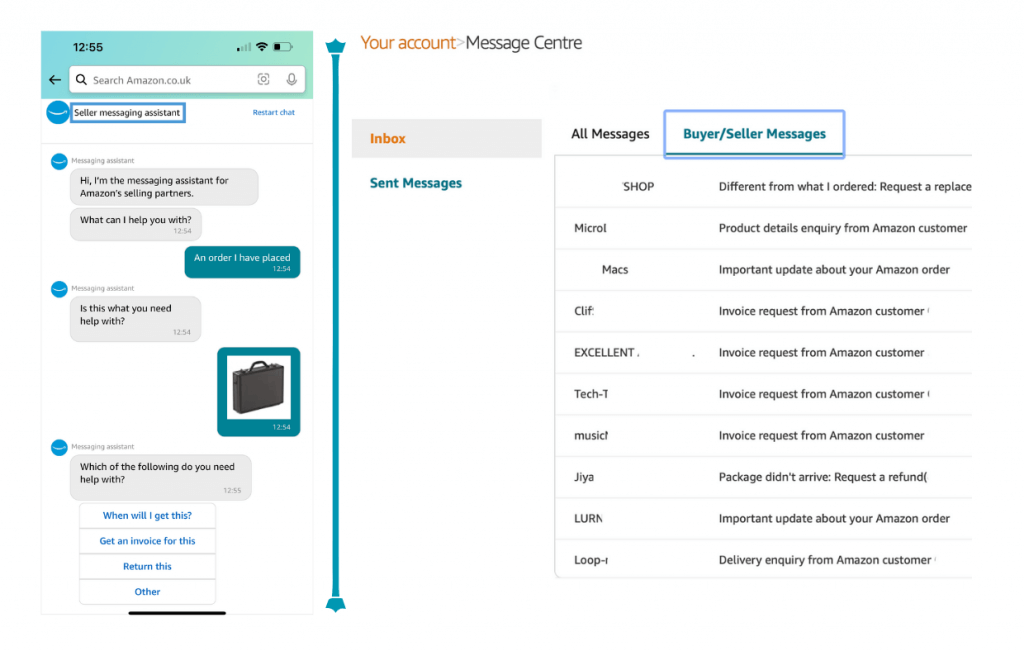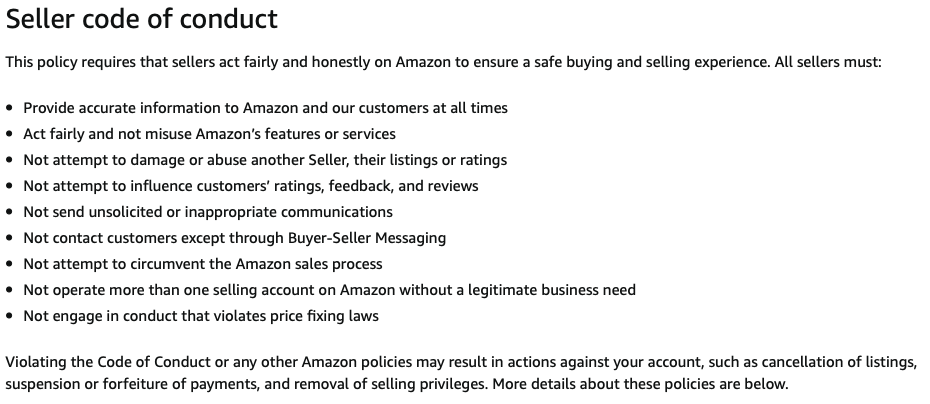
As a foreign seller, you may feel at times that your approach to customer experience isn’t fit for purpose. So, how do you handle buyer queries and demands in a way that builds trust and is on a par with Amazon’s own support services?
Amazon strives to be the most customer-centric company on the planet. This “customer obsession” sets a very high bar for third-party merchants, and especially foreign sellers. They must tap into the mind of a new kind of buyer, whose expectations, frustrations, and means of expression can be entirely alien to them.
So, let’s look at what Amazon.com expects from sellers based abroad with a few easy, customer-related guidelines. We show you how to handle buyer messages, reviews, and returns on Amazon so that you provide exceptional customer support. Here’s what every foreign seller on Amazon should know:
Communicating With Buyers
The only approved way to communicate with buyers on Amazon is the Buyer-Seller Messaging Service. Below are the ways a buyer can contact you. To the left, you’ll see the Seller Messaging Assistant on the Amazon app, while the web-based Message Centre is shown to the right.

What happens when a buyer contacts you? You have 48 hours to reply. But some messages come with a 24-hour reply target, as shown below. If you don’t provide an adequate reply on time, buyers can file a claim. As shown in, “A-to-Z Claims and How to Deal With Them”, a claim is never more than 3 steps away.
In this day and age, customers aren’t very fussy about typos and grammar, but it’s best to keep your messages to buyers concise and respectful. If you don’t have a native speaker or translator there to help with the proofreading, look for tried-and-tested email templates online.
AI tools can help you draft basic templates, translate messages, and even deduce customer sentiment. But they don’t understand the finer nuances of a complaint and they tend to produce emotionless and clunky content. If you must rely on technology, it’s better to try specialist customer support software.
If you still have trouble overcoming the language barrier, consider using Fulfillment by Amazon. This gives you access to multilingual support services from Amazon’s own staff over phone, email, chat, and social media around the clock. As you’ll see in “Amazon FBA 101”, switching has its pros and cons.
Finally, there’s another way to leverage the benefits of Amazon customer support without switching to FBA. There’s Customer Service by Amazon (CSBA). With it, you can outsource customer service to Amazon’s support staff, but also ship your orders yourself.
Handling Returns and Refunds
On Amazon, FBA and MFN (FBM and SFP) returns are handled differently. Amazon handles all refund requests for FBA items. But it’s up to you to deal with returns for seller-fulfilled orders. Below is a basic tutorial for MFN returns and refunds on Amazon.
Streamlining the returns process for your buyers will make it easier for you to handle returns and refunds, while also boosting customer satisfaction. We covered the basics of “Mastering Returns and Refunds” on our blog before. But here’s a recap of what you need to know about handling returns on Amazon:
- Buyers shouldn’t message you about a return. The Amazon app’s messaging chat tool offers a return option right off the bat. There’s also the Return or Replace Item button that they can access from their account on a web browser.
- The Online Returns Center works like a triage tool. It directs return requests to your Manage Returns dashboard. It also gives buyers automated options and instructions.
- Some customers may not be happy with their return options. You should create a clear return policy, publish it on your storefront A storefront is the page Amazon u… More, and direct buyers to it whenever there are disputes.
- When there’s a return request for an eligible item through the Online Return Center, you have 24 hours to approve or close it in the Manage Returns dashboard.
- In Return Settings, you can configure your return authorizations, label options, and even write your own return instructions.
- Aside from Prepaid Labels, you can also offer Free Returns if you’re enrolled in the Prepaid Label Program. This is a fuss-free, no-questions-asked and label-free return service.
- You can provide Returnless Refunds for cheap or fragile items by setting up Returnless Resolutions.
- Amazon applies a Refund at First Scan (RFS) policy, granting a refund as soon as the returned item is first scanned by a courier. Sometimes buyers receive their refund before you receive the item back.
- Amazon will automatically grant a buyer’s request for a replacement if you have another unit of the same item in the same conditionProducts can only be listed on Amazon if… More. If the buyer returns their item in 7 days, you must ship the replacement as soon as their courier collected and scanned it.
- If you disagree with Amazon’s decision to grant a return, replacement, or refund on your behalf, you may be eligible to file a SAFE-T claim for reimbursement within 60 days. Go to Orders> Manage SAFE-T Claims in Seller CentralAmazon Seller Central is a portal or a h… More.
- You can only charge a restocking fee for items returned late, used, damaged, or different from what was sent. You’re not allowed to charge restocking fees when the buyer cancels or changes their mind, unless it’s a video game or open software.
Dealing With Reviews and Feedback
When you’re dealing with reviews and feedback on Amazon, you must take extra care to follow the rules. Our Amazon Policy Violations Guide covers some of the most common mistakes for new sellers on Amazon. The Seller Code of Conduct, in particular, points out that sellers must never influence reviews and feedbackA performance rating on a scale of 1 to … More.

So, what can you do if you receive negative seller feedback or reviews? You’ll find everything you need to know in our previous post, “How to Manage Negative Feedback on Amazon”. To recap:
- Check the FeedbackA performance rating on a scale of 1 to … More Manager to see if your score was affected, download the Feedback report to look for similar feedback, and address the issue from Account Settings> Orders> Customer feedback problems. You can contact the buyer, post a public reply, or request that Amazon remove the feedback if it’s not related to your service.
- If your product review is non-compliant, you can use the Report Abuse button under it and call Seller Support, as shown by eDesk.
- Ask buyers to remove the feedback or review. Provide them with instructions and a direct link, if you have it.
- Apologize, ask for details, and offer to refund some of the shipping cost as a sign of goodwill.
- Be patient. Buyers have 60 days to retract their testimonials.
- If the testimonial is less than 90 days old and you asked Amazon to remove it but they declined, you have another 5 days to reopen the case. But you can only do it once.
- Never offer refunds or incentives in exchange for feedback or review removal, as it’s prohibited.
- Use a buyer opt-out notification tool if needed, to check that the buyer is receiving your message.
- Don’t try to trick buyers who don’t want to receive unsolicited emails. As shown below, this is cause for suspension.
- If the buyer refuses, don’t despair. With so many black-hat tactics, some customers find listings with a mix of positive and negative reviews and feedbackA performance rating on a scale of 1 to … More more authentic.
- If it’s a hopeless cause, put all your effort into collecting positive testimonials quickly, so that they cancel out the negative ones.
- Post a public reply to your feedback or review in a friendly tone and without placing blame. Offer solutions, give them thanks for raising an issue, and share your reasons for not being able to meet this particular customer expectation.
- Consider signing up for the new Amazon Selling Partner 360 program. In exchange for a fee, your dedicated Amazon representatives will handle a variety of business processes for you, including customer reviews management.
This rounds off our series on the topic of selling on Amazon. Dedicated to foreign sellers, it covered the basics of setting up an Amazon account, sourcing products, shipping them, and listing them. Now that you also know how to manage your online reputation and resolve buyer concerns, it’s time to focus on the exciting sales season just up ahead.

Melanie takes an active interest in all things Amazon. She keeps an eye on the latest developments and keeps Amazon sellers up to speed.




